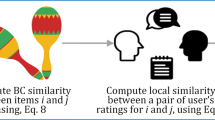Abstract
Rating prediction is a hot spot in the research of recommender systems. There are lots of methods in this field such as collaborative filtering. However, few of these approaches take users’ friendship relationships into consideration, which actually contain significant information for rating prediction. Besides, there exists natural noise in users’ ratings. In this paper, we propose a rating prediction algorithm named NF-SVM based on the analysis of users’ natural noise and relationships. We cluster users to sharpen the similarity attribute among users, and use an iterative algorithm to obtain the rank of users’ rating quality. Then, we analyze users’ rating history to obtain the attributes of users’ natural noise. All these attributes are used to build a training set for SVM to get a prediction model. We also tested our algorithm in a data set which is crawled down from Douban, one of the largest movie rating web sites in China. Then we compared our algorithm with other state-of-the-art rating prediction methods. Extensive experiments show that our algorithm outperforms the other algorithms.





Similar content being viewed by others
References
Amatriain X, Pujol JM, Tintarev N, Oliver N (2009) Rate it again: increasing recommendation accuracy by user re-rating. In: Proceedings of the third ACM conference on Recommender systems, pp 173–180. ACM
Breese JS, Heckerman D, Kadie C (1998) Empirical analysis of predictive algorithms for collaborative filtering. In: Proceedings of the Fourteenth conference on Uncertainty in artificial intelligence, pp 43–52. Morgan Kaufmann Publishers Inc
Carroll JM, Hoffman B, Han K, Rosson MB (2015) Reviving community networks: hyperlocality and suprathresholding in web 2.0 designs. Person Ubiquit Comput 19(2):477–491
Chung K-Y, Lee D, Kim KJ (2014) Categorization for grouping associative items using data mining in item-based collaborative filtering. Multimed Tools Appl 71 (2):889–904
Gong S (2010) A collaborative filtering recommendation algorithm based on user clustering and item clustering. J Softw 5(7):745–752
Guo G, Zhang J, Yorke-Smith N (2015) Trustsvd: collaborative filtering with both the explicit and implicit influence of user trust and of item ratings. In: Twenty-Ninth AAAI Conference on Artificial Intelligence
Hartigan JA, Wong MA (1979) Algorithm as 136: A k-means clustering algorithm. Applied statistics, pp 100–108
Hwang W-S, Lee H-J, Kim S-W, Won Y, Lee M-S (2016) Efficient recommendation methods using category experts for a large dataset. Inf Fus 28:75–82
Kim H-N, Ji A-T, Ha I, Jo G-S (2010) Collaborative filtering based on collaborative tagging for enhancing the quality of recommendation. Electron Commer Res Appl 9(1):73–83
Kong W, Liu Q, Yang Z, Han S (2012) Collaborative filtering algorithm incorporated with clusterbased expert selection. J Inf Comput Sci 9:3421–3429
Koren Y (2010) Collaborative filtering with temporal dynamics. Commun ACM 53(4):89–97
Wang F-Y, Carley KM, Zeng D, Mao W (2007) Social computing: From social informatics to social intelligence. Intell Syst, IEEE 22(2):79–83
Wei S, Ye N, Zhang S, Huang X, Zhu J (2010) A collaborative filtering recommendation algorithm based on user clustering and item clustering. J Softw 5 (7):745–752
Wen J, Zhou Z, Wang J, Tang X, Mo Q (2017) A sharp condition for exact support recovery of sparse signals with orthogonal matching pursuit. IEEE Trans Signal Process 65:1370–1382
Wen J, Chang X-W (2017) The success probability of the babai point estimator in box-constrained integer linear models. IEEE Trans Inf Theory 63:631–648
Wen J, Li D, Zhu F (2015) Stable recovery of sparse signals via lp-minimization. Appl Comput Harmon Anal 38:161–176
Lawrence I, Lin K (1989) A concordance correlation coefficient to evaluate reproducibility. Biometrics, pp 255–268
Li B, Chen L, Zhu X, Zhang C (2013) Noisy but non-Malicious user detection in social recommender systems. World Wide Web 16(5-6):677–699
Lu K, Zhang Y, Zhang L, Wang S (2015) Exploiting user and business attributes for personalized business recommendation. In: Proceedings of the 38th International ACM SIGIR Conference on Research and Development in Information Retrieval, pp 891–894. ACM
O’Mahony MP, Hurley NJ, Silvestre G (2006) Detecting noise in recommender system databases. In: Proceedings of the 11th international conference on Intelligent user interfaces, pp 109–115. ACM
O’Donovan J, Smyth B (2005) Trust in recommender systems. In: Proceedings of the 10th international conference on Intelligent user interfaces, pp 167–174. ACM
Page L, Brin S, Motwani R, Winograd T (1999) The pagerank citation ranking: Bringing order to the web
Puth M-T, Neuhäuser M, Ruxton GD (2014) Effective use of pearson’s product–moment correlation coefficient. Anim Behav 93:183–189
Ren S, Gao S, Liao J, Guo J (2015) Improving cross-domain recommendation through probabilistic cluster-level latent factor model. In Twenty-Ninth AAAI Conference on Artificial Intelligence
Seidl T, Kriegel H-P (1997) Efficient user-adaptable similarity search in large multimedia databases. VLDB 97:506–515
Shi Y, Larson M, Hanjalic A (2014) Collaborative filtering beyond the user-item matrix A survey of the state of the art and future challenges. ACM Comput Surv (CSUR) 47(1):3
Suykens JAK, Vandewalle J (1999) Least squares support vector machine classifiers. Neural Process Lett 9(3):293–300
Tang D, Qin B, Liu T, Yang Y (2015) User modeling with neural network for review rating prediction. In Proc. IJCAI
Tsunoda T, Hoshino M (2008) Automatic metadata expansion and indirect collaborative filtering for tv program recommendation system. Multimed Tools Appl 36 (1-2):37–54
Acknowledgments
This work was supported by the National Natural Science Foundation of China (61472024, U1433203), Development Program for Distinguished Young Teachers in Higher Education of Guangdong Province (Grant no.Yq2013147).
Author information
Authors and Affiliations
Corresponding author
Rights and permissions
About this article
Cite this article
Tong, C., Lian, Y., Niu, J. et al. A novel rating prediction method based on user relationship and natural noise. Multimed Tools Appl 77, 4171–4186 (2018). https://doi.org/10.1007/s11042-017-4481-8
Received:
Revised:
Accepted:
Published:
Issue Date:
DOI: https://doi.org/10.1007/s11042-017-4481-8




